A Spot Of Serene Beauty At Japanese Temple Sarnath To Get A Peaceful Atmosphere In 2025
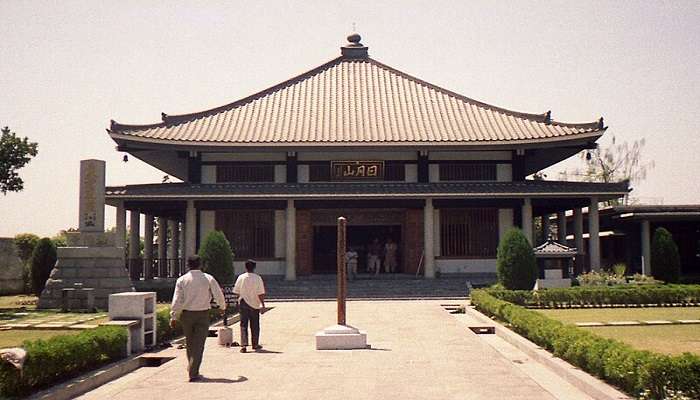
The Japanese Temple Sarnath, also known as the Nichigai Suzan Horinji Temple, is a prominent religious and cultural site in Sarnath, close to Varanasi. Buddhism is a religion which was started in India and then went on to make a deep mark among the public in Japan. This temple stands as a strong cultural bond between the two nations, both of which have a lot in common and to do with the Buddhist religion. Sarnath is known across the world and is a very important Buddhist pilgrimage site for the sole reason that the first Buddhist sermon was given by Lord Buddha, immediately after he attained enlightenment after his practice at Bodh Gaya. This article explores the Japanese temple at Sarnath in the North Indian state of Uttar Pradesh.
A Brief History Of The Japanese Temple Sarnath
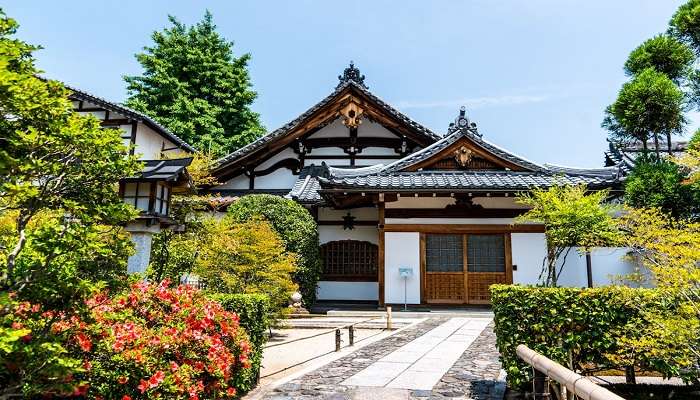
In 1989, work on the Japanese Temple at Sarnath began. It was founded due to the efforts of the Japanese Nichiren Buddhist organisation, especially those of the Nichigai Suzan organisation, which used Buddhist teachings to advance world peace and cross-cultural understanding. The temple was constructed to honour the Buddha’s teachings and to provide local followers and guests from other countries with a space for meditation, education, and spiritual growth. The Japanese Temple is a more recent addition to Sarnath’s religious landscape, symbolising the post-World War II resurgence of Buddhist ideology and cultural diversity. The temple’s construction was meant to solidify the Buddhist community in our country and create a place for Japanese pilgrims in the Indian subcontinent.
The increased interest in Buddhism and cultural heritage in the latter half of the 20th century saw a rise in the number of visitors coming to Sarnath. The Japanese Temple has a very unique style of architecture in the region, and it serves as a breath of fresh air for devotees and pilgrims who are trying to escape from the hustle and bustle of daily city life, both in India and abroad. In addition, the temple actively participates in both regional and global Buddhist activities. It regularly holds prayer meetings, meditation courses, and cultural events for the general public and devotees in general so that they may immerse themselves more in Buddhism. It also takes part in many interfaith discussions and programmes that promote world peace and understanding.
Must Read: Things To Do In Sarnath
Japanese Temple Sarnath – Age Old Beliefs In A Modern World

The Japanese Temple is just behind the government-run tourist house and can be reached from Sarnath’s primary market. This Japanese temple includes a double-story pagoda with a sloping roof that curves up at the eaves, giving it a serene appearance. Its aesthetics are typical of Japan. The temple is currently being run by a society called the Dharmachakra Indo-Japan Buddhist Cultural Society, which is in charge of the management and administration of the temple. Buddhist design ideas are blended with traditional Japanese aesthetics in constructing the Japanese Temple at Sarnath. The temple has an architectural style that is reminiscent of Zen meditation and minimalism, and it also includes features from many Japanese Buddhist temples, such as wood construction, a sloping roof, etc. With its unique Japanese-inspired design, the building hopes to inspire devotees and pilgrims of the Buddhist religion to find peace and harmony and to be able to synthesise Lord Buddha’s teachings.
The Buddha is shown in sculptures and images inside the temple, with the most prominent image being that of Nichiren, the founder of the Nichiren sect, which emphasises the Lotus Sutra as the major component of its practice. The Japanese Buddhist temple also houses many ancient Buddhist texts and relics, many of which are very essential to the teachings of Lord Buddha, that have been preserved over many generations. The temple’s beautiful architecture brings to mind the well-known Japanese temples in Kyoto, Japan. There is a statue of the Buddha in a serene pose just to the right of the main temple. The temple has a serene atmosphere that must be experienced by all travellers and pilgrims alike to understand the teachings of the Buddha and to get into a state of mindfulness. The temple’s interiors are serenely lovely. A massive wooden statue depicting the Buddha in a reclining position has a beautiful pattern on its head.
Suggested Read: Places To Visit In Sarnath
Places To Visit Around
Explore the famous nearby places and collect beautiful memories. Here are the details of the places to know about.
1. Dhamek Stupa
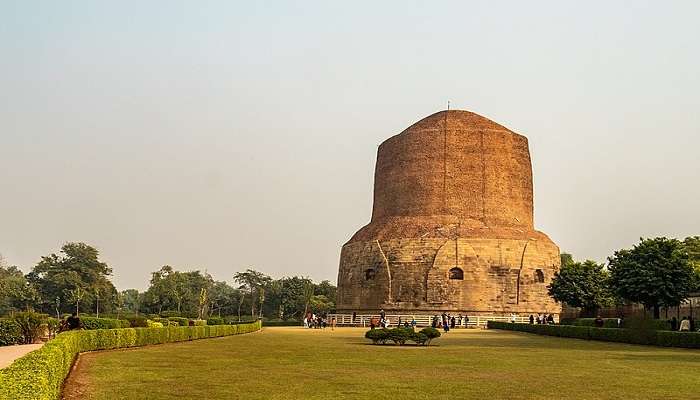
The Dhamek stupa is a very large stupa located at the ancient site of Sarnath. The site where the Buddha gave his first sermon to his initial group of five disciples, Kaundinya, Assaji, Bhaddiya, Vappa, and Mahanama, is commemorated by the Dhamek Stupa. Eventually, all five of these disciples of Lord Buddha achieved complete liberation from worldly “samskaras” and full spiritual enlightenment. The word “Dharmesksa” translated from Sanskrit to mean “one who ponders the Law of righteousness”. This word is the word from which “Dhamek stupa” originated and got its name.
In all of Sarnath, the largest building is the Dhamek Stupa. The stupa stands at a whopping height of about 43 metres, with a diameter of about 28 metres. The entire stupa is a solid brick and stone cylinder. It appears that the basement was part of Ashoka’s original construction, and the stone front has intricate floral decorations that are typical of the Gupta era.
Location: Dhamekh Stupa, Dharmapala Rd, Singhpur, Sarnath, Varanasi, Uttar Pradesh 221007
Timings: 6:00 am to 5:00 pm
2. Dashashwamedh Ghat
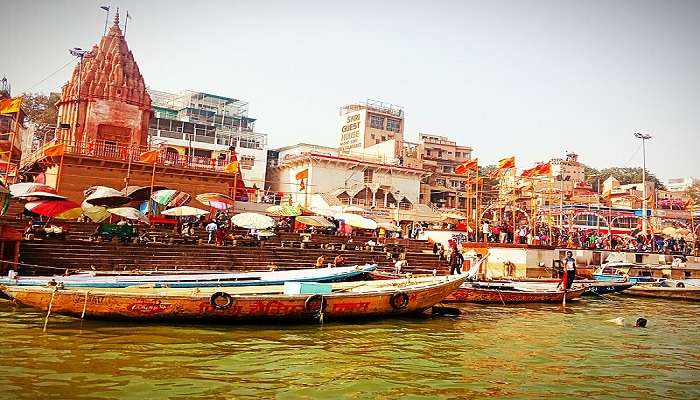
Situated on the banks of the Ganges River in Varanasi, Dashashwamedh Ghat is one of the city’s main ghats, and it has a lot of historical and spiritual connotations to it vis a vis its origin and rebuilding. It is situated adjacent to the temple of Vishwanath. Hindu mythology tells of a narrative that this ghat was built by Lord Brahma, the creator of the universe, as a way to welcome Lord Shiva to the city. Legend also goes that Lord Brahma performed the Ashwamedha Yagna 10 times (“Dasha”) at this spot. The current ghat was constructed in 1748 by Peshwa Balaji Baji Rao, and it was reconstructed in 1774 by Ahilyabahi Holkar, the Queen of Indore, a few decades later.
This ghat is also the site of the Ganga Aarti, one of the most well-known rituals involving the waving of lamps to honour and venerate the river and Mother Ganga, in Varanasi. Every day at sundown, people perform the Ganga Aarti, a rite in which they pray to the Ganges river. Flowers, lamps and offerings are also made to the river through tiny cups which they let float on the river. Numerous priests perform this Gange arati ritual by carrying large lamps and circling them up and down in a rhythmic tune of bhajans.
Location: Dashashwamedh Ghat Rd, Ghats of Varanasi, Godowlia, Varanasi, Uttar Pradesh 221001
Timings: Open 24 hours
Suggested Read: Things To Do In Varanasi
3. Chaukhandi Stupa
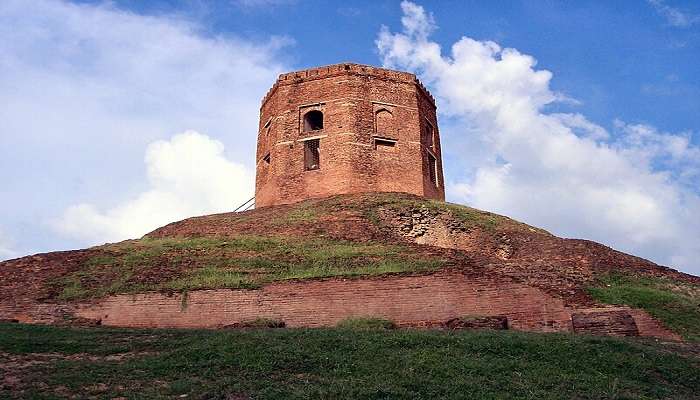
In Sarnath, Varanasi, there is a Buddhist stupa called Chaukhandi Stupa. It is believed that the Chaukhandi Stupa was first constructed as a tiered temple in the seventh and eighth centuries to commemorate the location where the Buddha and his first followers met while going from Bodh Gaya to Sarnath. Subsequently, to honour the arrival of Humayun, the Mughal monarch, Govardhan, the son of Raja Todar Mal, built the octagonal tower, changing the stupa’s original shape. The stupa is now a tall earthen mound with an octagonal tower atop a brickwork structure. The Archaeological Survey of India has been in charge of its upkeep ever since they designated it as a monument of national significance in 2019.
Location: 92FF+JC4, Rishpattan Rd, Near, Sarnath, Varanasi, Uttar Pradesh 221007
Timings: 6:00 am to 6:00 pm
Further Read: Sarnath Hotels
The establishment of this Japanese Temple Sarnath goes on to show the true impact and the role that Buddhism has had over both India as well as Japan, and the influence that it has exerted on the masses of these two countries over millennia. So do visit this beautiful temple while planning your trip to Varanasi.
For our editorial codes of conduct and copyright disclaimer, please click here.
Cover Image Credit : Ryan for Wikimedia Commons
Frequently Asked Questions About Japanese Temple Sarnath
What is the Japanese Temple in Sarnath and why is it significant?
The Japanese Temple in Sarnath is a Buddhist temple built by the Japanese Buddhist community. It stands as a symbol of peace and is a significant spiritual site, reflecting the shared religious heritage that traces back to the life of Siddhartha.
Is there an entry fee for the Japanese Temple in Sarnath?
Information about entry fees for temples in India can vary and change periodically. Typically, many religious sites are accessible without an entry fee.
Are there any dress codes to be aware of when visiting the Japanese Temple?
Yes, as with many religious sites, visitors to the Japanese Temple are expected to dress modestly, covering shoulders and knees as a sign of respect. It is also advisable to remove footwear before entering the temple, as is customary in many religious sites in India.
Is photography allowed inside the Japanese in Sarnath?
Photography policies may vary at different structures in the complex, so it's best to inquire at the temple regarding any restrictions before taking photos inside.
Can non-Buddhists visit the Japanese Temple in Sarnath?
Yes, the Japanese Temple is open to visitors of all faiths. Tourists and pilgrims alike are welcome to explore and experience the temple's peaceful environment.
People Also Read:
Agung Jagatnatha Temple Yamunotri Temple Kashi Vishwanath Temple

Unveil the hidden treasures of the globe and turn every travel dream into reality. As a Content Writer, I am passionate enough to craft stories from ancient wonders to modern marvels. My words paint the picture-perfect itinerary for unforgettable experiences. Let my words be your trusted guide to immerse in the diverse culture and discover the beauty of the unknown.











